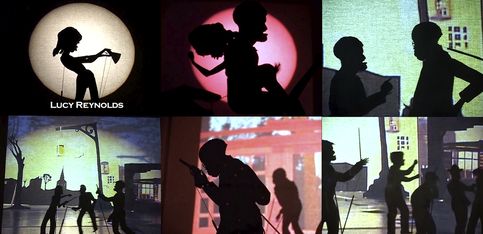National Archives Microfilm M999 Roll 34: Bureau of Refugees, Freedmen and Abandoned Lands: Lucy of Pulaski

Kara Walker
National Archives Microfilm M999 Roll 34: Bureau of Refugees, Freedmen and Abandoned Lands: Lucy of Pulaski, 2009
Videoinstallation Video, color, sound, 12 min 8 sec Edition: 1/5 + 2 A.P.
GF0031836.00.0-2021
Artwork text
In the Generali Foundation Collection is the 2009 video work National Archives Microfilm M999 Roll 34: Bureau of Refugees, Freedmen and Abandoned Lands: Lucy of Pulaski. It tells the true story of a woman named Lucy and was created as a result of Walker's research on the U.S. National Archives Bureau of Refugees, Freedmen and Abandoned Lands, which was established in 1865 to help freed slaves build new lives in freedom. The archive conducted meticulous investigations into incidents of violence against freed slaves and houses the records. Walker uses the report of one specific case as a script for a video. It is about a young black woman named Lucy who was accused of sexually debauched behavior that was the alleged cause of riots that occurred in Pulaski, Tennessee, in 1868. Pulaski is the birthplace of the Ku Klux Klan, founded in 1865 by Confederate veterans as a vigilante group that continues to target blacks with active violence today. It was first mentioned in the National Press in connection with the Lucy of Pulaski incident. It is the story of the rape of a young black woman by a white man. In the aftermath, a fight broke out between whites and blacks, leading to rioting and a targeted, organized attack by armed whites on blacks, some of whom were seriously wounded and others killed. In a kind of film prologue, the actors are briefly introduced with their names superimposed. The shadow play makes white and black actors the same. The artist deliberately adopts external clichés and stereotyping as a grotesque device to distinguish the characters, who are depicted in the form of caricatured silhouettes. Walker does not shy away from giving space and time to the brutal scenes, which drastically demonstrate the act of sexual violence as a demonstration of power and the street fights with their unequally distributed means of struggle. The shadow play in this case is created with flat puppet figures, which the artist herself moves by hand on rods. In this way, she takes up a technique used by the German silhouette animator Lotte Reiniger (1899-1981), who experimented with early forms of animated film beginning in the 1920s and created the first surviving feature-length animated film, The Adventures of Prince Achmed, in 1926, eleven years before Walt Disney presented Snow White and the Seven Dwarfs. (Doris Leutgeb) The original text from Freedmen's Bureau can be read online: http://freedmensbureau.com/tennessee/outrages/orangerhodes.htm Wikipedia article on the Pulaski Riots: https://en.wikipedia.org/wiki/Pulaski_riot